The Story of Hewey - part 2! |
|
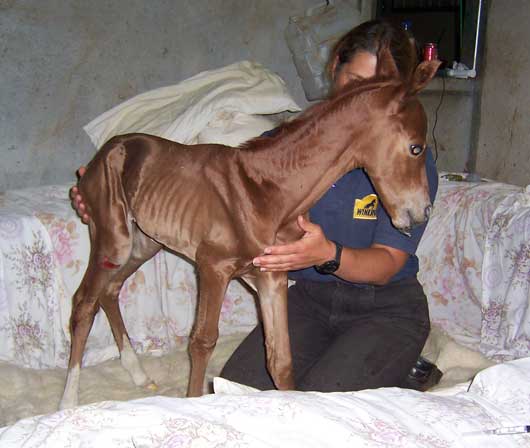 |
|
Thursday dawned and we had made it through the night. Of course there was no sleep for the humans in this story so our foal was probably in the best condition of the group! He could not be left alone because he didn't know that he couldn't stand up. His knees and hocks were at risk of collapsing because the bones hadn't calcified. This would of course have been terminal. The other issue was that he had imprinted on me as his mother and so like all foals, would go into a panic if I disappeared from sight. For these reasons the other horses had to be fed and all of our chores done by Richard. Breakfast was then taken in the stable, and at some point I was able to make a trip to the bathroom! This could only happen during his short sleeps and with someone else present in case he woke up. |
|
We were pretty pleased with the progress of Hewey but our hearts sank when our vet, Des James, arrived at about lunchtime and as soon as he saw him started shaking his head saying ‘he is very premmie isn’t he, he is very premmie’. It was about now that we started doubting the 300 day rule. We had been keeping track of his feeds by our standard method of hospital charting, that is, by writing on the wall of the stable. This is an invaluable tool in making sure that records don’t get lost and that medication is delivered on time. Our aim was 1 litre of colostrum in the first 24 hours, as after this the foals gut can no longer absorb the antibodies. He was now 12 hours old but not yet halfway there even though he apparently had a good appetite. Des was very doubtful about the prospect of survival for this foal but he did agree that he was amazingly bright and strong (given that he basically had no body fat, no hair on his body nor bones in his knees or hocks!). His heart and lungs sounded good and all other vital signs were practically normal. Des said that the only chance of getting him through was intensive nursing, make that very intensive nursing. The straw was clearly not soft enough and we had already put a foal rug under him, however Des gave us instructions on setting up a long-term area for him, a soft bed in a protected cell! It was to be one bale of straw wide and two long. The straw had to be wrapped in bed sheets so as not to damage the very delicate skin. On the bottom we had a foam dog bed with towels and then sheets over the top. Mum (Phyl) and my aunt (Nancy) lent us sheets and towels and Des actually lent us his ‘foal nursing stash’ of sheets, towels bedspreads etc (which mum had to go and collect for us). We were struggling to find soft enough bedding and mum donated a single bed woolen underlay, which we put over a foam ‘eggshell’ mattress overlay. This was pretty good but of course we needed duplicate sets to keep up with the washing. Over the next few days we added another underlay and some sheepskins and also some pet bed synthetic sheepskins. In fact donations of bedding came from many friends. We also needed pillows to prop him up on to help him ‘sit up’ and aid his lung function. |
|
We were to start Benzyl penicillin 8 hourly and continue to get the colostrum down the hatch. The benzyl pen is faster acting than normal procaine penicillin. The disadvantage is that it comes lyophilized (in powder form) and so needs to be reconstituted prior to use. Of course this means one has to remember to make it up! Also I neglected to say earlier that the colostrum was frozen in 250 ml lots. It needed to be thawed very carefully in order to preserve the valuable antibodies and then warmed to drinking temperature in very small (and somewhat unpredictable) lots in clean bottles for each feed. After Des had left we actually weighed the foal for the first time. Not on horse scales but with me on the bathroom scales holding him! He weighed 22 kilos. Remember he was by a 16.3 stallion out of a big 16.2 mare and so should have been around 60 kilos. As with any foal the first 24 hours would be critical. If we got through this, then tomorrow we would take the next steps in patient management. |
|
This (Thursday) was the last day before Des went on holiday and, although he didn’t say so, he was so doubtful that our tiny foal would survive, he did not even do a hand over to another vet. However by 11pm Hewey (who incidentally was not yet named) had consumed his litre of colostrum and was now ready to start on milk collected from his mother. Our aim was to have Gloria take over the role of mother at some stage so not only did we milk her but also held Hewey up to her on numerous occasions to try to keep some bond between them. This was a little difficult as the foal was rather terrified of the great big brown thing outside. Never the less we made sure that we kept the top door of the stable open for Gloria to look in. By the time he was 24 hours old, Hewey had consumed one litre of colostrum and 375ml of milk. |
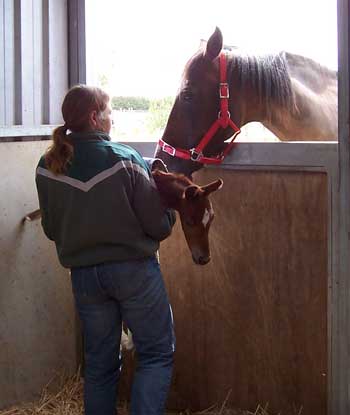 |
On Thursday morning I was still alert enough to cancel the days lessons however as the day wore on I forgot to cancel the horse physiotherapist for the Friday morning and missed canceling a Friday lesson. These people were very understanding and none of the horses missed their physio. Hewey was born on the Wednesday night and Richard was booked to be away from Friday to Monday and there was nothing that we could do about it. Anyone that came to visit invariably received a job of some sort. At this stage these ranged from feeding me to feeding horses. Life as we knew it ‘before Hewey’ had ended. The first task for Friday was to establish Heweys immune status. His veins were so tiny and soft and I was so sleep deprived that I enlisted the help of our friend Liz from Bolinda Thoroughbreds to collect the blood. The Ig G was run and sadly there was no clotting after 2 hours. Surely this could not be correct with our ‘high class’ colostrum there must be some Ig G there! |
|
| Mum made the trip to the vet to get another test but that also showed zero Ig G. By this time it was early afternoon and Richard had gone for the weekend. Hewey could only be left alone if he was asleep, which was usually for a short time after a feed. During this time I had to prepare his next feed, which meant washing bottles and teats (a job shared with anyone who was present) and milking Gloria (not a shareable job). I also had to make up feeds for all the other horses (and then hope I could get someone to feed them) and organize the cats and dog etc. I think that it was Friday evening that Mel had arrived to ride her horse and somehow found herself feeding up! Hewey could not have been raised without the help of family and friends. |  |
Rohan Luxmoore was the vet that drew the short straw and was requested to come out that afternoon to assess Hewey. We needed complete confidence in the recommendations given. Rohan spent hours explaining the treatment that Hewey could need and the likely outcomes if all went well and what hurdles could be thrown up. As we already thought we knew (in broad terms) the nursing would need to be extremely intensive. He would need a minimum of 2 bags of plasma ($$$$), all legs splinted ($$$$$) with the splints changed regularly to accommodate growth and guard against pressure sores, antibiotics and ulcerguard every 8 hours for about a month, turning very two hours so that he did not get pressure sores, cooling in the heat, warming in the cold, confinement for at least 2 months, not to mention just feeding him and keeping his bed clean, and no guarantee that he would even survive let alone turn into anything other than a poorly conformed runt!! How is he still alive you may well ask! Rohan left me to mull over this and also to consult with Richard over the phone. I think my opening line in a very shakey voice was ‘I think we are going to have to put him down’ to which Richard responded ‘ we have to give him a chance’. The problem was of course that it needed to be all or nothing and to do this a major portion of money would be spent in the next few hours. A long discussion ensued and we decided to give it a go. |
|
| Poor Rohan then had to come back to administer the plasma and splint the legs. The splints were very complex as we had to protect any bony projections from rubbing. They also had to be able to bear his weight if he stood up and completely support and protect his joints. Even though Hewey was a pretty good patient, this took hours and I think that it was nearly midnight when he was finished. It was a three man operation in a very tight and awkward space and we were lucky to have the help of another friend Deb. | 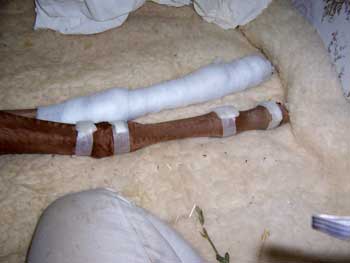 |
| Hewey was now 48 hours old and was blissfully unaware that he had cost a small fortune. He was firmly convinced that I was his mother and was apparently pretty happy with his lot. I had not really slept since Tuesday night other than a couple of naps in his bed. I found that I could fit across the end with my legs up on the bales and that Hewey could then rest on me for support and warmth. If I fell asleep he found it easy to wake me for a feed. | 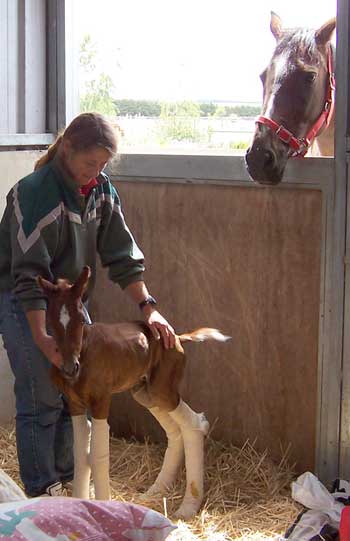 |
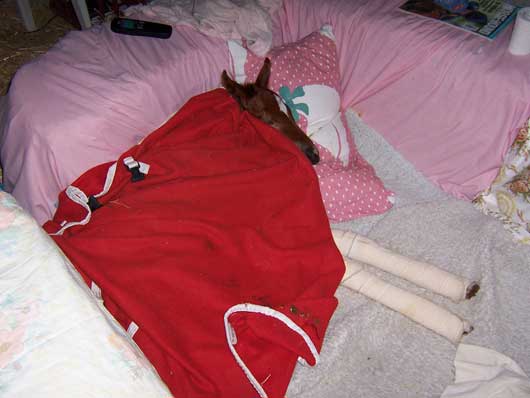 |
|
| Nighty night Hewey! | |
Follow this link to part 3! |
|
| Visit us on Facebook! |
| And on YouTube! |